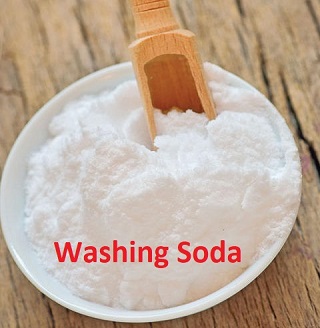Washing SodaWashing Soda is an alkaline compound, which is highly alkaline or basic in nature with a pH value of 11. Its chemical formula is Na2CO3.10H2O and is chemical name is sodium carbonate decahydrate. It is also known as soda ash as it can be obtained from the ashes of burned plants. Washing soda is a sodium salt of carbonic acid and is made of two sodium ions and one carbonate ion. Its molar mass is molar mass of Na2CO3 is 106 g/mol. 
Washing soda is known for its ability to remove stubborn stains from clothes. It is a powerful water softener. It softens the water by binding to the substances that make water hard and allows the clothes to absorb detergent properly for better cleaning. So, it is found as the main component of detergents. Properties of Washing Soda
Preparation of Sodium Carbonate I Solvay processThe preparation of washing soda involves Solvay process that includes the following steps; Step 1: Formation and Purification of Brine and formation of ammoniated brine solution In this step, first, the concentrated solution of sodium chloride is prepared through evaporation. This solution of NaCl is known as brine. The impurities present in the brine are removed by precipitation. Then the concentrated brine solution is filtered and ammonia is mixed with it in the ammonia tower that results in the formation of ammoniated brine solution. Step 2: Formation of sodium hydrogen carbonate In this step, carbon dioxide is passed through the ammoniated brine solution. A chemical reaction occurs that gives ammonium chloride and sodium bicarbonate as products. This process occurs in a carbonated tower. The chemical reaction that takes place is shown below; NH3 (aq) + CO2 (g) + NaCl (aq) + H2O → NaHCO3 (s) + NH4Cl (aq) Step 3: Formation of Sodium Carbonate The sodium bicarbonate formed in the previous step is collected from the tower. It is then heated at a temperature of 300 degrees centigrade that leads to the formation of anhydrous sodium carbonate as shown in the below chemical reaction; 2NaHCO3 → Na2CO3 + CO2 + H2O Step 4: Formation of Sodium carbonate decahydrate 10 water molecules are to sodium carbonate which forms hydrated sodium carbonate, which is called Washing Soda. The reaction is shown below Na2CO3 + 10 H2O ---> Na2CO3.10H2O Step 4: Recovery of ammonia Ammonia used in this process can be recovered from ammonium chloride (NH4Cl) formed in the second step. It is obtained by the reaction of a solution of ammonium chloride (NH4Cl) with Ca (OH)2. The chemical reaction is shown below. This recovered ammonia is reused in the Solvay process. 2NH4Cl + Ca (OH)2 → 2NH3 + CaCl2 + H2O Uses of Washing Soda
Note: Washing soda may be dangerous in large quantities, so make sure it is away from the reach of children and pets. Since it can cause skin irritation, you should wear gloves while using washing soda.
Next TopicMetals and Non-Metals
|
 For Videos Join Our Youtube Channel: Join Now
For Videos Join Our Youtube Channel: Join Now
Feedback
- Send your Feedback to [email protected]
Help Others, Please Share










